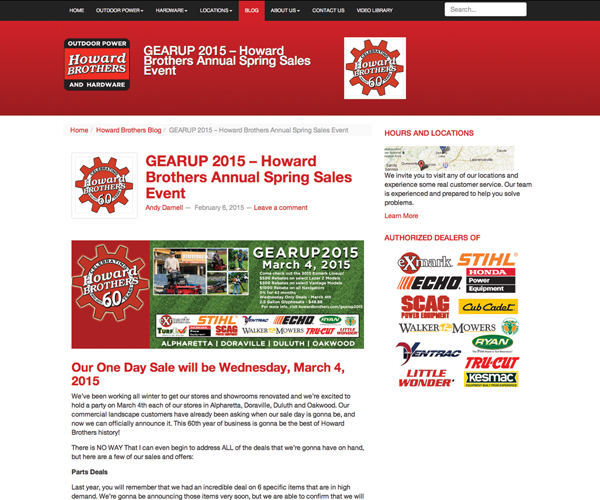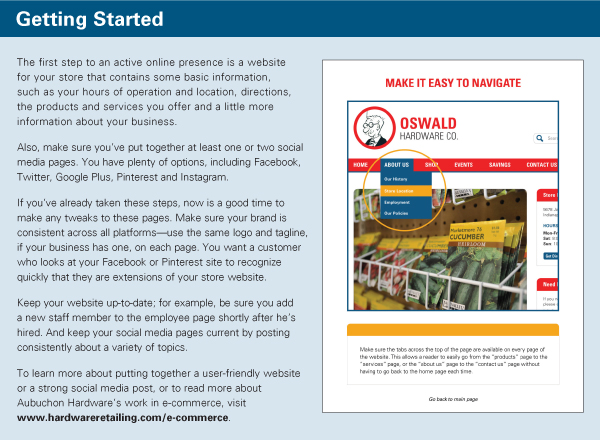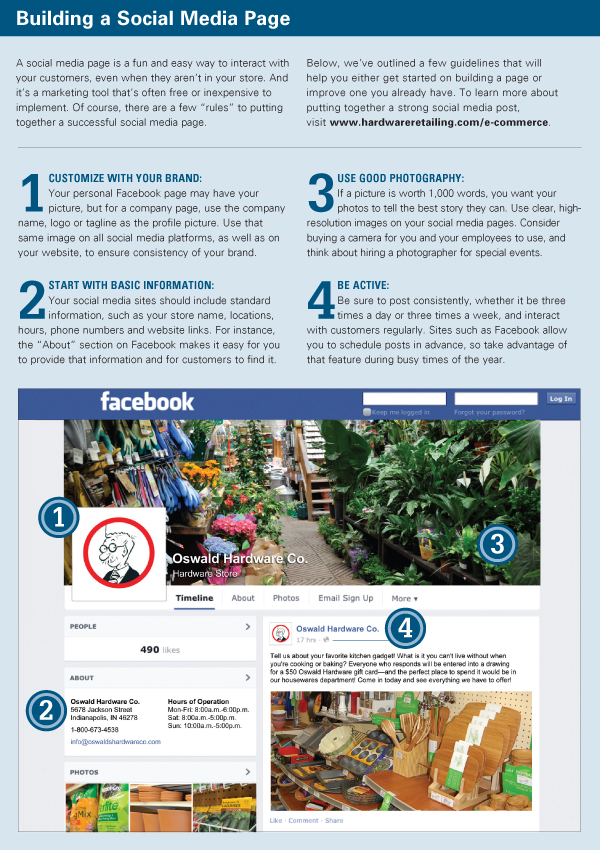To view a PDF of this story, click here, and visit hardwareretailing.com/e-commerce to download an interactive PDF highlighting the different elements of an effective retail website.
Making the Most of Your Internet Presence
By Liz Lichtenberger, llichtenberger@nrha.org and Kate Klein, kklein@nrha.org
In 1994, the first physical product was sold online. In case you’re wondering, it was a pizza purchased with Pizza Hut’s then brand- new online ordering site.
E-commerce has grown for Pizza Hut since then—in April 2013, the company launched an app allowing Xbox 360 users to order food through the gaming console. In four months, Pizza Hut earned more than $1 billion in sales through that app.
When online shopping became popular in the 1990s, you probably thought it meant you could ship a product from your store in Arizona to a customer in New Jersey. And while that’s exactly right, e-commerce has become so much more than that. It now allows you to special-order products, ship items from warehouse to store for customer pickup and more.
Now that the concept of online retailing has had more than two decades to mature, we thought it was time to ask the question: Are any independent home improvement retailers doing it right?
What we found was that, while very few retailers have put together a comprehensive online solution to meet all customers’ needs, there are many retailers who do a good job with specific elements of online retailing.
In the following pages, we’ll talk about how to develop some best practices in the online sphere. First, we’ll discuss how you can use the Internet to take your marketing and promotions to the next level. Next, we’ll turn to a topic that’s even more challenging: e-commerce, and give you some ideas of how to build your online selling sites.
MARKETING AND PROMOTIONS
The idea of building an e-commerce site may be intimidating. The first step to making the most of your online presence, however, isn’t offering a state-of-the-art website allowing customers worldwide to shop your store online.
Rather, get started with a basic store website before building up your store’s social media presence and incorporating email marketing and other online components.
“The web and social media are here, and they’re here to stay,” says Bill Jablonowski, owner of Jabo’s Ace Hardware, which has three locations in Texas. “If we don’t use them for our stores, we’re missing out on some huge opportunities.”
Try first using the Internet to connect your brick-and-mortar store with the online world by using your website as the hub of your online presence, then adding in social media, email marketing and more. Below, we’ve included some best practices on how to do this.
And, for those of you who have already taken these steps, we also discuss ways to improve your online presence.
Websites
When customers visit your company’s website, there are a few things they’re looking for: information about your business; products and services you offer; the store’s address; and contact information, such as a phone number and main email address.
To start building your website, talk to your distributor. Many offer website services and can help you build an effective website. Or you may choose to create a customized site.
Andy Darnell, director of marketing for Howard Brothers, which has five locations in Georgia, built his company’s website from the ground up using WordPress, a popular content management system.
“The biggest thing is to have a site that can be easily managed,” he says. “Your website is never completed—it isn’t static. You should be managing it and adding to it all the time.”
If you aren’t sure how to go about building your own website, other companies can help. Jablonowski hired an outside company, Bluetent, to build his site.
“We use it to get information out about who we are and what we offer,” he says. “We put our circulars and upcoming events on the site, and we make changes to it regularly.
“Our goal is to keep it fresh and relevant for our customers,” he says.
Both Howard Brothers and Jabo’s Ace have incorporated mobile compatibility into their sites, making it easy for customers to find what they need from their smartphones or tablets. A mobile friendly store website should allow customers to find directions and contact information quickly.
If you have any online selling tools, make sure to include links to them on your information website.
Neither Darnell’s nor Jablonowski’s stores allow customers to buy online directly from the store, but they do offer other options.
Howard Brothers has an online catalog that is used to showcase, rather than sell, products, and the Jabo’s Ace site has a link to its distributor’s e-commerce site for any visitors interested in purchasing online.
Social Media
Today, it seems like everyone has a Facebook account. And many of your customers—most likely your younger ones—will have accounts on multiple social media outlets, including Twitter, Pinterest, LinkedIn and Instagram.
It’s important to know your audience and know which types of outlets offer the best ways to reach out to your customers, and update them regularly.
If you choose to use more than one—and you probably should—there are ways to manage posts across platforms.
Jablonowski calls his business’s Facebook page “our bread and butter” but says the store is also on Twitter, Instagram, Pinterest, Foursquare and Yelp.
While many posts are scheduled to go out simultaneously on different outlets, Jablonowski says his son, Zach, who manages the company’s social media accounts, also focuses on different concepts for different sites.
“On Pinterest, we want to put more visual concepts out there—how we are cooking, decorating or painting,” says Jablonowski.
“On Facebook, we post a lot of our offers, and we remind people of different products we sell. We’ll tell them we sell Big Green Eggs and then go on to include a recipe and some additional product information.”
Howard Brothers uses many of the same social media sites. It also has a YouTube channel and frequently posts how-to videos.
“I use those videos mainly to promote new products in the store,” Darnell says. “I’ll also retweet or share pertinent information from other vendors. We do a lot with outdoor power equipment, so if Stihl, for example, has posted something relevant, I make sure to share or retweet it so our customers can see it.”
He also regularly updates the store’s blog, aiming to add a couple of new posts each week.
“Most of the posts are seasonal,” he says. “Right now, we’re getting ready for spring, so we’ve been talking about lawn mower sales and other related events.”
He recommends knowing your audience when you reach out on social media. For example, most Howard Brothers customers are commercial landscapers, so Darnell posts information that will be useful and relevant to them.
Howard Brothers uses HootSuite, a multiaccount social media management service, to schedule and manage social media posts across the different platforms.

Darnell also makes sure his social media marketing connects with traditional marketing.
“Our print circulars will have the same component as our blog posts, and the radio spots will be related, too,” he says. “We want our customers to hear something on the radio and then see something about it when they visit our Facebook page or our blog.”
In addition to using your social media outlets regularly, it’s important to promote them to your customers.
Many Howard Brothers employees have business cards, and those have the website and social media links printed on them.
At Jabo’s Ace, Zach Jablonowski puts the logos for the different social media outlets on all of the company’s marketing materials created in-house.
“We follow our distributor’s advertising, but anything we do that’s branded solely as Jabo’s will have those links on them,” says Bill Jablonowski. “Of course, we have them on our website as well.”
Email Marketing
It’s important to tie your print marketing in with email marketing concepts. Instead of relying solely on traditional circulars and snail mail marketing tips, try emailing your customers with circulars or other messages about upcoming sales, promotions and discounts in your store.
Jablonowski has gotten a number of email addresses thanks to his distributor’s customer rewards program, and he also collects them whenever he offers contests at the store. He uses this email marketing list to reach out to customers about different promotions or workshops being offered at the store.
One key, he says, is not to overdo it. “We try to save our emails for something local at one of our stores, like an Amy Howard paint workshop. We know our customers are receiving emails from our distributor as well, and we don’t want them receiving too many.”
Online Newsletters
Keep customers posted on what’s happening in your store by sending the news directly to their email inboxes. Customers may see something they like and come into your store when they wouldn’t have otherwise made the trip. Online or e-newsletters can bring those extra footsteps into your store.
It’s important to, again, know your audience and what type of material they’ll be interested in, as well as keep up with current topics that you can cover in your online newsletter.
At Howard Brothers, Darnell sends out about one email newsletter per month.
“I’ll share popular posts from the website,” he says. “I include a featured article and then three or four secondary articles. The secondary articles have already been published on the website, but the main article is specifically written for the newsletter and is more content-heavy.”
He often chooses articles based on current trends or hot topics, such as square-foot gardening or the use of ethanol in gasoline.
“Our online newsletter isn’t for sales purposes,” Darnell says. “It’s quality content that shows we are experts in what we do. I want our customers to share that content, and in order to do so, they’ll have to find it interesting or informative.”

Mobile Apps
No matter what you want your smartphone to do, a quick search will turn up an app for just about anything. Consider creating an app for your store, as a way to not only inform and entertain customers, but to make your store stand out from the competition. At the very least, make sure your operation’s website uses a responsive design that allows the website to be seen easily on a variety of mobile devices.
Your store’s app could contain the contact information and driving directions that are on your website (and should be easy to find on the mobile version of your website), but it could also include games or promotions. It’s easier than it sounds—you probably already offer plenty of contests or other promotions in your store, so all you need to do is add an online aspect.
Jablonowski relies on his distributor’s app, but he has considered trying one of his own, too. The app he’s considering is one that will help his company gain more exposure within the local community.
“We believe in going mobile—that’s what everybody does,” Jablonowski says. “However, I want to advertise without bombarding people with too many emails or social media posts.”
The app he’s considering is geocoded and very highly targeted, meaning it should be helpful in reaching the correct audience.
“I think we might give that a try on a pilot basis this year,” he says. “It’s something we need to do now, not in 2016 or 2017.”
WHERE DO I GO FROM HERE?
So, now you’re well schooled on best practices for managing your informational website and social media and email marketing. Good.
But if you’re going to sell product online, the expectation from your customers will be a safe, convenient experience. You’ll need to establish best practices in online retailing, too, and we’re here to help with ideas other retailers are putting into practice.
For many of you, basic e-commerce sites were easy to start because most distributors offer store websites you can customize, as well as access to their online catalogs for ordering. Others have built their own online selling tools, or worked with outside web development companies to do so.
Several big independents have built up robust e-commerce businesses already. For example, Aubuchon Hardware, which has more than 100 stores in the Northeast, has a massive, successful e-commerce business started in 1999. Aubuchon fulfills online orders from its own distribution center, with many employees taking care of web customers.
But, since many of you are just getting started in e-commerce, we chatted with retailers from smaller operations who can provide you with insights into how best to help your customers when selling products online. These retailers are learning to turn web stores into services that complement their successful brick-and-mortar businesses.
What Customers Want
When done well, e-commerce—despite being a tenuous profit builder—can strengthen your customers’ reliance on your business as a go-to resource for home improvement products.

However, online selling success stories aren’t simply matters of publishing pretty websites and filling orders from across the world as 1990s techies once dreamed. Business is tough, retail competition is stiff and even the experts struggle to earn comfortable margins online.
Yet, Amazon and other major web retailers have trained consumers to expect easy and secure online access to extensive product descriptions, pricing and ordering options.
You’re not exempt from needing to meet those consumer expectations with similar online services, but you’ll lose shoppers if you don’t have best practices in place.
If you sell product online, you will need to create an easy, safe, e-commerce experience shoppers can trust. Then that online business will need to earn enough money to support the website and justify the employee time spent on it, as well as hopefully turn a profit. Doing those things well is the challenge.
“E-commerce is rapidly changing, and I think everyone’s figuring out their strengths as commerce and technology evolve,” says Kyle Little, co-owner of North Carolina-based Little Hardware.
It’s Customer Service
The good news is that you don’t have to compete with giant online marketplaces such as Amazon. Rather, you can use e-commerce to promote the existing local impact of your stores as an extension of the stellar customer service you already strive to offer. Whether in person or online, that service is what your customers already expect.

For Klem’s in Spencer, Massachusetts, e-commerce was an amenity consumers wanted, so the business gave it to them.
“We’ve kind of built our business over the years on what the customers have asked for,” Klem’s president Jessica Bettencourt says. Klem’s sells a wide variety of product, including tractors and clothing.
For a long time, consumers asked Klem’s to offer online shopping so they could check if an item was in stock prior to heading to the store. The consumers didn’t necessarily want to buy product online, but they did want to see what items the store carries, how much they cost and whether a roof rake or lawnmower would be available when they walked through Klem’s doors, Bettencourt says.
About five years ago, Klem’s created an online store and has been working hard to make it serve customers well, like the brick-and-mortar store does.
Necessary Services
Whether they’re earning money or not, e-commerce sites have to meet specific, basic customer needs, Bettencourt says.
Those basics include detailed product descriptions, photographs, secure payment methods, quantity of product available and delivery options.
The online services can be labor-intensive to offer. For example, customers want to see photographs and detailed product descriptions, whether they purchase online or not, Bettencourt says. Moving images and product information from distributor or vendor catalogs to the website can be easy, but not all distributors or vendors provide photographs, and the item descriptions might require rewriting or editing, she says.
Little Hardware has about 35,000 different products for sale in its brick-and-mortar store in Charlotte, and about 16,000 online because there’s no easy access to pictures and information about all of the products. Local vendors have less information to provide, unlike larger suppliers or distributors with master catalogs.
Customers also want product shipping and pickup choices. Some buy an item on a website and have it shipped to them, while others order and then pick up the products at physical stores. To provide another option, Ace Hardware is piloting a same-day delivery program to homes, work sites and businesses within 5 miles of certain Ace stores.
What to Sell
Not all items make sense to sell online. For example, Klem’s doesn’t sell large equipment on its website but does post information about the products.
If a customer buys a tractor, Klem’s staff doesn’t want the person to pick it out and pay online for such a major purchase without ever visiting the store. Rather, they want to talk to customers about how they will use the tractor and what model will best suit their purposes.
“Selling product isn’t always about ringing it through the register. A lot of selling product is meeting customers’ needs,” Bettencourt says.
Make It Easy
As a rule, online ordering should be convenient. Customers order online for a variety of reasons, such as wanting to eliminate trips to a store, reserving products that might sell out, buying at any time of the day or night and having their purchases waiting for them when they drop in at your business.
Some customers want to pick up their orders at Klem’s, especially if they’re local people buying high-demand products at a promotional price, Bettencourt says. Klem’s gives customers that in-store pickup option.
Other consumers simply want to check online if Klem’s carries a product, and verify the item is in stock before heading to the store.
Selling online, though, can mean selling out of products on the shelves—and Klem’s and other businesses are trying to navigate the issue to prevent customer service blunders that defeat the purpose of ordering online.
Similar to a brick-and-mortar store, you have to find a balance of not overstocking items simply because there’s a slight chance a big web order might come in, but also not running out of products so you can easily give your customers what they need. Selling out, online or in store, could lose you customers.

Stocking “has been a huge, huge obstacle,” says Jonathan Miller, co-owner of Miller Hardware Company in Valdosta, Georgia.
Miller Hardware can’t always fill a large online order quickly due to low in-store inventory, but can’t overstock, either, he says.
The Klem’s website syncs with the store’s internal inventory system, but sometimes an order can come through online while in-store shoppers have product in carts, Bettencourt says.
Customers who have paid online don’t want to show up at the store to pick up an order, only to find the quantity available dipped after the in-store shoppers paid for the items in their physical shopping baskets, she says.
To avoid that problem—they’re learning as they go—Klem’s now removes products from the website if store inventory gets low, she says. Klem’s, Little Hardware and Miller Hardware fulfill orders from their brick-and-mortar locations.
Serve the Customers
For the retailers who spoke to Hardware Retailing, e-commerce isn’t going to replace their brick-andmortar operations anytime soon.
But regardless of profitability, if you have an e-commerce platform, it has to provide a shopping experience that serves your customers. An online store doesn’t equal easily earned income from buyers around the world. Many of your online customers are your in-store shoppers, and they already account for your business’ overall profitability.
Little Hardware’s e-commerce site is an online presence that helps prospective customers find out about the store, the products it sells and where the business is located, co-owner Kyle Little says. The store also offers the website as a service, similar to online banking, that existing pro customers can use to manage their accounts with Little Hardware.
Like Klem’s, Little Hardware launched the e-commerce website because consumers wanted to find product information and the option to order online.
Klem’s 5-year-old web store accounts for less than 1 percent of the company’s sales, and about 4 percent of Miller Hardware’s sales are online.
“I can tell you that putting a site out there and hoping that people magically find, trust and purchase from you is a fantasy,” Little says. “You have to put work into it. The Internet will not simply serve you.”
Neither Klem’s nor Little Hardware has had business expand far beyond local customers. Of the shoppers who buy from KlemsOnline.com, about 70 percent have local addresses, Bettencourt says. The convenience of the Klem’s website attracts existing customers, and the online information sends some new faces to the brick-and-mortar store.
“I think, really, it’s about trying to provide for your customers in the best ways that you possibly can, and hopefully, along the way, gain some new ones,” Bettencourt says.
Starting the e-commerce site was an effort to make Miller Hardware more progressive and respond to customers’ requests for an online channel, Miller says. It’s currently pretty easy for hardware stores to stay old-school, but that’s shortsighted, he says.
“I think if you haven’t already started, then you’re behind the game. I think it’s going to become a standard sooner than people think,” he says.
He likes the fact that his company can now sell product across the country, and even to customers in other countries.
“I can’t think of any negatives, besides the investment in time. It’s not something that happens overnight, and I wish we’d gotten started 10 years ago as opposed to four,” he says.
Miller hopes to grow the store’s e-commerce business to 10 percent of the company’s revenue this year.
Enhance the Experience
Little believes the local retailers who do best online are building off of their brick-and-mortar business models to enhance existing customers’ experiences. He is working toward that end.
“Yes, there’s online sales, but you have to recognize the market that you’re in and what your strengths are,” Little says.
About 70 percent of Little Hardware’s in-store customers are commercial or industrial clients, and most of those have charge accounts and get billed monthly for their purchases. For those customers, online account management through the Little Hardware website is efficient, and the store promotes the service to them. Ordering online can also be convenient to those pro consumers, Little says.
Making online both a strong customer service tool and a profit earner is a game that’s changing and challenging.
 Hardware Retailing The Industry's Source for Insights and Information
Hardware Retailing The Industry's Source for Insights and Information









